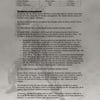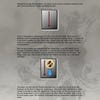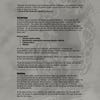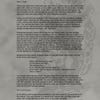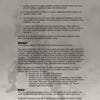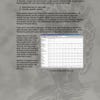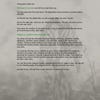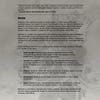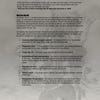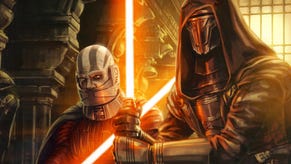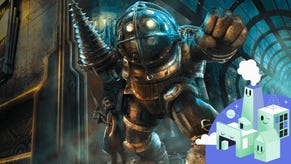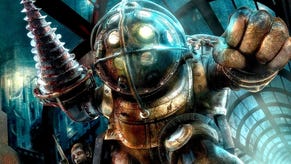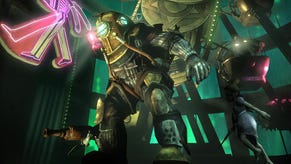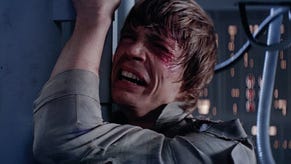Rapture leaked: The true story behind the making of BioShock
From the archives: Simon Parkin investigates the torturous making of a masterpiece.
Now that BioShock: The Collection is here, we thought it might be interesting to revisit the original game's troubled development. Enjoy!
25th January 2007 was a cold day, even by the harsh standards of a Boston winter. That morning, a dozen senior members of BioShock's beleaguered development team shuffled into a hidden room in the centre of the city, and stood to face a pane of one-way glass. As a huddle of strangers entered the adjacent room, unaware that they were being watched, the team from Irrational Games fell silent. After five years of arduous development, during which time the game's setting had shifted from an abandoned space station overrun with alien eels to a deep sea utopia project gone wrong, the team was about to see whether all of the toil, all of the late nights and all of the seven-day weeks had been worth the effort.
Ken Levine, the game's creative director, held a clipboard that listed the strangers' names and their vocations (all of whom were in their twenties). Security guard, construction contractor: these were blue-collar video game players. Through the glass, Levine and his team watched as each person sat down at one of the various television sets arranged around the room and played the game. They began at the very start: a plane crash over the ocean. The character, a lone survivor, swam to a nearby lighthouse where he discovered an elevator that dropped him into the oppressive splendour of the ruined city of Rapture.
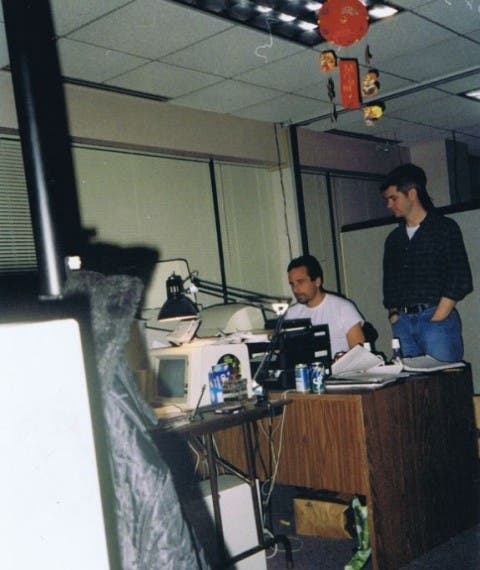
After an hour or so, the men put down the controllers and gathered for a Q&A session to answer questions about what they'd seen and played. The players spoke candidly, not knowing that the developers could see and hear everything. The feedback was brutal. The game was too dark. They didn't know where they were supposed to go. They had grown weary of collecting all that loot. Nobody trusted Atlas, the disembodied voice who acted as both welcoming party and guide to Rapture. One attendee described Atlas, who at the time spoke in a Morgan Freeman-esque Southern drawl, as a "lecherous Colonel Sanders". Another player somehow missed the fact that Rapture was an underwater city. Most of the group found the story entirely confusing.
The feedback was direct. It hurt. With only a few months to go before the game's release, the temptation for the designers was to criticise the players, rather than listen. Someone pointed out that one of the players didn't seem to know how to hold the controller properly. Someone else cast aspersions on the players' literacy: perhaps these people lacked the education to catch the game's highbrow references? Someone else suggested that they had perhaps shown off the wrong sections of the game. Jonathan Chey, one of Irrational Games' three co-founders, suggested the way that the session had been organised was as much of a problem as the game itself. But behind the carapace of bargaining, everybody knew there was truth to what had been said.
"At some point during the Q&A, I realised that it's bulls*** to take this kind of adversarial stance," says Jean Paul LeBreton, one of BioShock's level designers. "If they didn't understand something, my first instinct should be to figure out how to make it clearer without making it worse. Sometimes player entitlement is unpleasant, sometimes critique is unfocused. There is almost always truth hidden in it, though." Levine, the weight of a $25m underwater world on his shoulders, agreed. "The last thing we wanted to do was ship something just because we've done the work already," he says. "Looking back at it, you think of those days as some of the high points, because those are the ingredients for making something special. They are the price that you pay."
***
Paul Hellquist was fired on his first day at Irrational Games. "It was a running gag that Ken Levine had at the time just to freak out the new guys," he recalls. "It worked." It's an unusual way to welcome a new staff member to any company, the sort of mild hazing usually meted out in college fraternities. But it was perhaps indicative of the studio's small size and lack of experience at the time. Hellquist, who had no previous experience in the industry, joined Irrational in September 1999 when the company was run out of a four-room office with vast windows and exposed brick that had previously housed a school.
"Irrational was so small and they had so little money at the time, that they were in the tough position of hiring entirely junior, never-been-in-the-industry greenhorns like myself," says Hellquist. "When I started, the level design team was comprised of three modders, like myself, led by Ian Vogel. I was not qualified, but they needed to take fliers on rookies with the limited budget they had at the time."
Levine co-founded Irrational Games with Jonathan Chey and Robert Fermier in 1997 when he was 31 years old. The team was comprised of former employees from Looking Glass, another Massachusetts-based game developer, and initially the Irrational team worked out of the Looking Glass office. "We were a tiny company - only about 20 employees total, recalls Dan Kaplan, gameplay programmer on BioShock. "Any time someone came up with something cool, the entire company would quickly know about it and would be riffing off it - it made for a great sense of accomplishment with even the smallest creative efforts. There was a real sense of unity."
"I think that the pressure Ken felt to deliver a successful blockbuster corresponded, at many points on the project, to his unpleasantness with the team."
JP LeBreton
Irrational's first project was System Shock 2, a science-fiction horror title that pioneered a number of new techniques in interactive storytelling, which the team co-created with their former colleagues at Looking Glass. The year after System Shock 2's release, Levine sent a two-page pitch for a sequel to publisher Electronic Arts. The document was bare bones, describing how the previous game's cliff-hanger would be resolved. EA rejected the idea, most likely because, while System Shock 2 was a critical success, it was also a commercial failure.
While Irrational continued to work on other projects - Deep Cover, a cancelled game made in conjunction with Looking Glass, Freedom Force and The Lost, a game that was completed but never released due to legal complications - Levine wanted to return to System Shock's freeform, immersive style of narrative.
The first demo for what would become BioShock was created in 2002 for Microsoft's first Xbox using Unreal Engine 2. Set within a utopian project turned to dystopian ruin, the underwater city of BioShock's Rapture has become one of video gaming's most enduring locales. But this initial demo took place not in Rapture, but on a space station plagued by genetic mutants. Enemy designs were pulled directly from B-movie science-fiction with working names like 'eel man' and 'jelly man'.
Around this time the story centred on a protagonist called Carlos Cuello, 'cult de-programmer' (Levine borrowed the name from one of Irrational's own programmers). While the team struggled to work out what game they wanted to make and how they wanted it to look, word that the studio was working on a game in the System Shock lineage got out.
While the team struggled to work out what game they wanted to make and how they wanted it to look, word that the studio was working on a game in the System Shock lineage got out. LeBreton, who grew up in Texas, applied for a job at the studio after reading that the studio was working on the spiritual successor to System Shock 2, the game that had inspired him to enter the games industry. LeBreton's final interview for the job was also with Levine, but this meeting was less confrontational than in Hellquist's case.
"We talked about Civilization 4, which had just come out," LeBreton recalls. "Ken opened the game's box and unfolded the tech tree with relish." The young designer's impression of Levine was lasting. "I felt that I was in the presence of a hero," he said. "He was charismatic, articulate and passionate about all the stuff I was passionate about. We were going to work together and raise the standard of what games could be. I was thrilled."
"There I was, my first day and I'm s****ing on other people's work."
Bill Gardner
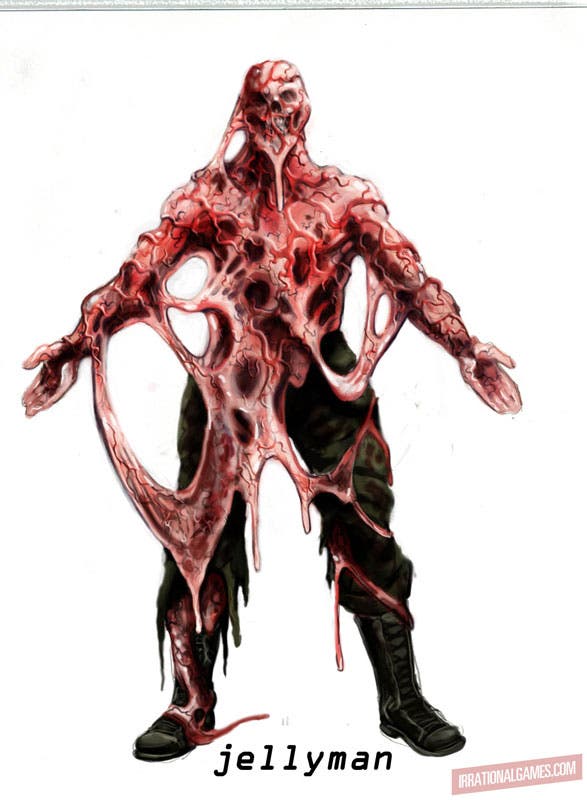
Levine had a talent for finding and inspiring young game-makers. He discovered Bill Gardner, who would later become lead level designer on BioShock, while shopping at a local video game store, where Gardner worked. "Ken was a regular," says Gardner. "Somehow I hit it off with him and he invited me to apply for a job in QA."
On Gardner's first day he was assigned a game to test. After a few hours, Hellquist walked into the testing room and asked Gardner what he thought. "I told him it was great," says Gardner. "Then I asked him about a particular quest in which you had to kill spiders. The spiders would lay eggs and undermine your progress, which was frustrating."
Hellquist grabbed Gardner and frog-marched him into a design team meeting. "There I was, my first day and I'm s****ing on other people's work," says Gardner. "I'm totally unprepared, but I make my case. Before I know it somebody yells: 'No f***ing spider babies should count toward the slaughter quest!' It was the first of many impassioned debates about design. But I think that speaks a lot to the sort of environment we had."
***
In late 2004, Irrational formally announced BioShock. The response from the press and public was unanimous excitement, and this positivity permeated the studio. As the game moved from pre-production into full-scale development, the studio left its loft in South Boston and moved into a larger office in Quincy. For the first year of development there were only six team members. During the next two years this number would swell to 60, partly thanks to an influx of money when the video game publisher 2K acquired the studio in late 2005 (although this wasn't announced until January 2006).
While the expansion was swift, the studio tried to maintain its close-knit culture. "Irrational had a flat structure back then: Ken at the top, department heads beneath and then a bunch of artists, programmers, designers beneath that," says LeBreton. "This worked well for the studio's size. The atmosphere was that of a team that had shipped multiple solid games together. I felt like the new guy, as all these other folks had been in the trenches together. But I felt like I fit in."
There were, however, problems brewing, ones that would almost entirely scupper BioShock's development and which would resurface during the development of its follow-up, BioShock Infinite, Irrational last game before the studio was closed earlier this year.
***
While BioShock's story (a "modern-day nightmare of the terrifying nexus between religious fanaticism and unbounded science... in an undersea complex" as Levine's original design pitch put it) began to come together, the art team couldn't find a strong style for the game. "The project struggled at the beginning to develop a visual identity," says Chey, director of product development at Irrational at the time. "There was a period of time where the levels looked like typical grey industrial space corridors and the opponents were the usual mutated monsters that you'd fought a hundred times before."
Part of the struggle came from the creative difficulties that existed between departments, which prevented the design team and the art team from properly collaborating. "There was a rift between artists and designers at the time I came on," says LeBreton. "Early in 2006, we hired a new level artist named Hoagy de la Plante. He picked up on the same cultural tensions within the team and asked for permission to work with me on a week-long experimental level-building process, in which we collaborated closely on a small space."
"We were both pretty new at the time, and we didn't have some of the historic friction between Irrational's design and art departments that influenced some of the other studio veterans," says de la Plante. "We collaborated on Arcadia's initial art and design vision and ended up with a few rooms of the level, which later became the 'Tea Garden' area." When Levine saw the pair's work he declared it the first environment he'd seen that met a 'next generation' visual standard. "Ken showed off our work to the entire studio as an example of a great BioShock space, as well as an example of what can happen through cross-disciplinary collaboration," says de la Plante. "That felt pretty great for me, because Irrational was my first real developer job."
While the rifts didn't disappear with the shift in working process, they also didn't curdle into the sort of dysfunction that can destroy a blockbuster game at its foundations. Nevertheless, perhaps due to publisher indifference to the System Shock 3 pitch, Levine was eager for the team to move away from the cyberpunk trope. "Ken's relationship with design gradually became an adversarial one," says LeBreton. "I think that the pressure Ken felt to deliver a successful blockbuster corresponded, at many points on the project, to his unpleasantness with the team."
"At the time, creating a game that was set in an underwater failed utopia espousing objectivist values didn't really seem like something that the public at large would enjoy."
Shawn Robertson
Despite the natural creative friction seen by most large teams who work on a blockbuster project, many of BioShock's most memorable ideas were born of successful collaboration. LeBreton claims that he originated the idea of introducing mind-control as a way to instruct the player on what to do next in the game through the narrative. "I thought that those 1950s-era 'subliminal messages' seen in movies like The Manchurian Candidate might be a more novel way to restrict a player's access than the traditional locked doors and keys. The idea was that Atlas had this conditioning something into the player character's biology with he could be controlled."
During the first half of 2006, Hellquist wrote an outline script for each area in the game that Levine could work from when he came to write the first draft of the dialogue. Hellquist had the idea of making the control a spoken phrase. Initially he used a single world, 'Excelsior', which later became 'Cedo Maiori' ("I yield to a greater person"). But these phrases too obviously signalled Atlas's treachery. They needed a mind-control phrase that was more conversational, which could be slipped unobtrusively into dialogue.
As the team prepared to show off the game at the E3 games conference in 2006, Levine began to work on a marketing tagline for the game. He settled on, "Would you kill people, even innocent people, to survive?" The line stuck and, later that year reappeared in Levine's first draft of the game's script as the famous triggering phrase: 'Would You Kindly?'
Not every aspect of the game evolved so effortlessly. At one point the team needed to create a demo for the American video game magazine Game Informer. The magazine was set to run a BioShock cover story. "The pressure was on to create something that would impress, and our deadline was looming," says LeBreton. "In a level review, there was some discussion of how an AI should be presented in the short demo. Someone mentioned System Shock 2's evasive cyborg ninjas as a reference point. Ken threw his glasses down and yelled: 'I don't want to hear anything about any f***ing cyborg ninjas!'"
When Paul Hellquist, lead level designer on the project tried to interject, Levine screamed: "Shut up!" "This stunned everyone into silence," recalls LeBreton. "This was still early in my time at Irrational, and I wasn't sure what to make of it. Other folks were upset, but in a way that indicated this was something that had happened before."
"One of the central themes of BioShock's development was the tension between our initial aim to make a spiritual sequel to System Shock 2 and the need to make a very successful mass-market console game," recalls LeBreton. "Shortly after the game's strong showing at E3 2006, Ken emerged from discussions with 2K marketing and announced to the team that we would be marketing the game as a shooter - but not to worry, we were still making the same smart FPS/RPG hybrid, we might just make a few small design adjustments here and there to make it accessible to the Halo crowd." Lead artist Shawn Robertson understands why 2K made the change. "At the time, creating a game that was set in an underwater failed utopia espousing objectivist values didn't really seem like something that the public at large would enjoy," he says.
"Anything that reminded Ken of the nerdy roots from which BioShock sprang was terrifying to him."
JP LeBreton.

As the game's budget swelled, the pressure to create something with mass-market appeal increased in kind. LeBreton considers that Levine's outburst derived not only from a desire for creative rigour, but also fear. "I think it stemmed from a growing lack of trust in the people he'd hired." Levine's strong objection to the reference to 'cyborg ninjas' may also have stemmed from a tension between his own formative nerd interests, and the desire for his work to reach a wide, mainstream audience and to be respected as a creator outside of the video game playing public. During a BAFTA interview in 2013, Levine talked candidly about how, as a lonely child, he would play Dungeons & Dragons by himself. Video games were "my only friend," he said at the time. "Anything that reminded Ken of the nerdy roots from which BioShock sprang was terrifying to him," says LeBreton.
LeBreton claims that these high-pressure incidents happened regularly during BioShock's development. "There was always some thematic connection," says LeBreton. "Someone was always being 'sand in the gears', a phrase Levine used a few times to describe his time at Looking Glass, when he battled designer and programmer egos. The pressure was on him and he probably felt people didn't see the gravity of the situation, or have his clarity on the broader project."
Chey, who by this point had been sent to run 2K's Australian studio but who continued to spend most of his time in Boston, agrees. "Ken and I always had a core idea of what it was we were trying to create. Even if we couldn't see that in the build in front of us, it was always important for us to continue to believe in it and try to communicate that vision to others who couldn't see. It's easy to get overwhelmed by negativity but, as a director, you have to keep that inside and not let it sway you from your course."
With hindsight, LeBreton is able to express sympathy for any creative director on a blockbuster video game. "They are expected to be both godhead and pontiff of vast collaborative projects, un-insulated from either the fiscal realities that hang over them or the daily difficulties of making games. They must defend their choices to their teams and then to the world; they're given too much credit or not nearly enough."
Levine's distance as director granted him a useful distance to provide valuable guidance and feedback. "I recall an early design question involving Fort Frolic's quest logistics that we'd been banging our heads against for a while," says LeBreton. "Ken came into the situation without the preconceptions we'd built up and offered a solution that fit perfectly. He cherished such victories. I remember him saying early on that he saw himself as the Cassandra of the project, the Greek princess granted the gift and curse of prophecy."
***
Another source of tension for the Irrational team and the game's publisher 2K was the Little Sisters, the young girls who harvest stem cells from corpses left lying around Rapture. The Little Sisters started life as armoured slugs and, while the design changed to little girls, they remained vulnerable; the player was supposed to prey on them. This murderous interaction matured into the idea that the player could also 'save' the Little Sisters, by performing a form of exorcism.
"For a while, this was implemented as a plasmid that you'd fire at them," recalls LeBreton "They'd double over and start rejecting the slug, and their protectors, the Big Daddies, would take this as a sign of aggression, so you were still in for a big fight. Saving the girls was a harrowing process, and it was ambiguous as to whether 'saving' them was even doing them a favour."

Towards the end of 2006 Levine and Chey were unhappy with the system. "We couldn't really figure out how to make them work properly, and we thought about cutting them a number of times," says Levine. Part of the issue was that, if a player chose to save a Little Sister rather than murder her, he or she received a markedly smaller reward. One team member recalls 2K's boss Greg Gobbi saying: "We are not shipping a $25m product where the player gets punished for doing the right thing." Moreover, 2K was nervous that the fact players could kill children in the game would cause issues with the ratings board. "In the trenches we were pretty sure it was a no-go," says LeBreton. "I remember booting up Deus Ex with the team present to confirm that, yes, you can trivially kill children in the game's second mission... but that was released into the game industry of 2000, before Hot Coffee..."
"The way the player interacted with the Little Sisters was always going to be a tricky issue," says Chey. "Not because of what upper management thought of it, but because of what the press and the public would think. We were worried about it. We weren't looking to create controversy and we didn't want outrage to overshadow the real point of the game. We had to find a solution that conveyed the tough decisions we wanted the player to make without bringing out the mob and the pitchforks."
The team's solution was to make the Little Sisters invulnerable, only allowing the player to harvest or save the child after their assigned Big Daddy was eliminated. "This involved writing a massive kludge into the game's fiction that I still cringe thinking about," says LeBreton, "but maybe it was the only way given the other constraints."
***
As BioShock entered its final year of development, the pressure on the team to work ever harder increased. "Two of the lowest points on BioShock's development were when mandatory six and later seven day weeks were instituted," says LeBreton. According to the designer the decision to force the team to work without days off came directly from Levine; the game's producer, Alyssa Finley (who would later become studio head of 2K Marin) was against the move. "I'm dubious of any real quality gains from the decision," says LeBreton, "especially given the morale cost."
The team would find different ways to cope with the bruising workload. "I needed a break from all of the late nights but didn't know how to switch off,” says John Abercrombie, a programmer at the time who later became AI lead on BioShock and lead programmer for BioShock Infinite. "I didn't want to play pinball or whatever so I decided to replace the grenade that the grenadier AI used with a 3D model of a cat, which would explode on contact." Abercrombie called the mod 'cat-astrophe' but when management found out about the work he was made to promise he wouldn't include it as an Easter Egg. "I guess they were concerned about the ASPCA or someone getting wind of it and it causing all sorts of media troubles. So I just made a video locally and then went on, fixing bugs."
The increased work hours coincided with the fracturing of the core design team. "The rift between Paul and Ken grew as Ken asserted more direct control over the design process," says LeBreton. Hellquist was increasingly shut out of key meetings. "The reasoning seemed to be that time was short and some decisions could only be made by the most critical people, and Paul was either deemed non-critical or considered an impediment to the decision-making process."
Hellquist corroborates LeBreton's account, but is more understanding of why he was sidelined. "The shift upset me and ultimately led to my departure," he says. "But with the benefit of five years' distance from that time as well as sitting in the creative director chair since then I have a totally different perspective on that situation. I was a pain in Ken's ass towards the end of development. I was constantly challenging his opinions and directives and, having sat in that chair now, I expect he was exasperated. In retrospect I should have been more quick to say: 'OK, I'll do it.'"
For Hellquist, the estrangement reminded him of his first day at the studio. "I felt that, despite eight years at Irrational, Ken still thought of me as the junior level designer who he fired on my first day," he says. "I thought he should consider me his equal. I felt my opinions deserved more weight than they received." Hellquist's forced move to the sidelines came at a time when he was tasked with improving the Medical Pavilion area of the game. "I was no longer asked to be involved in meetings. It hurt, but I channelled that frustration into making that portion of the game as good as I possibly could." Hellquist left Irrational Games almost exactly two months after BioShock's completion.
Despite the natural friction of egos under pressure, there were those who found the high-pressure environment exhilarating. Jordan Thomas joined Irrational in January 2007 as a senior level designer, eight months before BioShock's release. "I remember the hunger," he says. "I came on late, but you could smell it, like an animal; everyone there had something to prove. And when we let ego fall away, and that engine of collective intent began to roar, man - there was a beauty to the naked momentum of it. Maybe you were at the wheel, maybe you were fuel. On the best days at Irrational, it didn't matter."
Thomas, who would go on to found 2K Marin with LeBreton, where he directed BioShock 2, remembers the sense of elation when a design fell into place. One night he was working on the area of the game for which he was responsible, Fort Frolic, where an insane artist, Sander Cohen, holds the player captive. "Chris Kline, lead programmer at the time, was there at 2am with me, and would give me a first read on new content. I was trying to show him Cohen's big final entrance scene, and had been tinkering with it for several days, with the savvy assistance of JP LeBreton.
"That night, though, some minor bug fouled it up. Chris left to go home." Thomas remained at his desk and, after some time, solved the issue. "In the scene Cohen descends - applauding himself. There's canned cheering and the music swells... but the only people there to observe his work are you, his prisoner, and the dead. Oblivious in my pride I stood to my feet, arms thrown up, and bellowed: 'IT IS DONE!' to a completely empty building. As Cohen sat there in his looping poses, admiring his masterpiece, I realised that, in a way, I had become him."
"We had to find a solution that conveyed the tough decisions we wanted the player to make without bringing out the mob and the pitchforks."
Jonathan Chey
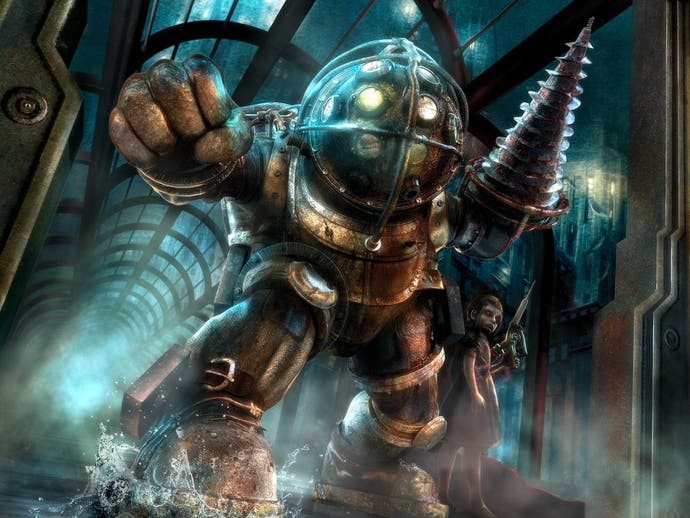
As BioShock neared its scheduled completion date and the natural pressures on the team intensified, the game's publisher made an announcement that startled the team: they had added three extra months to the schedule in which to finish the game. It was double-edged news offering the prospect of three more months of physically and psychologically exhausting seven-day weeks, but also the opportunity to realise the game's grand ambition. "I think the team, or at least I was happy to have had the time to be able to polish the game more," says Levine.
"When Ken stood up in front of the team and announced that we had three extra months to work on the game, it was a mixed feeling," recalls Robertson. "We had been crunching for a while and were ready to get the game out the door, but on the other hand, we saw those three months as a way to put that extra bit of polish in and really ship something we were proud of."
"Any time a game you're working slips, it is definitely a little demoralising," says Keith Shetler, assistant producer on the project. "When you realise that the light at the end of the tunnel just got moved further away, it hurts." Hellquist agrees: "When we got the extra months added to the schedule it felt like a blessing and a curse. I was excited because I knew that was the time we needed to really make something special but the curse was that we knew we had more months of crunch before we could rest."
The wearying news was made more palatable for some staff members by the fact that they felt like they were on the verge of greatness with the project. "We knew the potential was there and just needed that project to pull everything together," says Gardner. "In every way fathomable, BioShock was that project. I imagine it's how a band feels before they enter the studio to record their breakthrough album. There's just an energy."
Other team members were less certain the game would be a success. "I'm the guy who is always looking for problems - with the goal of trying to find solutions, of course," says Chey. "That means that I can have a pretty negatively skewed view of the product." Shetler is even less equivocal: "I didn't think anyone would like it."
The play-test behind the one-way glass in January 2007 only seemed to confirm these fears. But, after the initial sting of the criticism, the team went away and redoubled their effort. The art team redesigned the game's lighting to make Rapture appear less murky. A great deal of work went into reworking the control, UI and feedback. The team implemented a 'quest arrow' to direct the player on where to go next (much to the chagrin of some designers). Atlas was recast as an Irishman. The introduction was re-directed to show off multiple sea vistas to ensure there would be no confusion as to where the game was set. As the final submission date approached, confidence grew.
***
Towards the end of a video game's production the issue of accreditation is raised. How one's work is credited in a video game is important not only for validating one's sense of contribution, but also as an essential part of establishing a career record. With blockbuster productions, establishing the boundaries of authorship can be difficult, especially when the project is led by something of an auteur.
"Ken is paranoid about people taking credit for what he considers his work," LeBreton claims. "He chose people's titles in the credits carefully and did the same for the BioShock Infinite team. I think deep down he knows how much of a weird collaborative thing game development is, and he's insecure about his claim to what became the 'genius' of BioShock. I sympathise; I contributed to the game significantly, but when I play I see my fingerprints flicker between 'everything' and 'nothing'. In video games so many people touch the work and no idea is the same in two or more minds."
"I remember Levine saying early on that he saw himself as the Cassandra of the project, the Greek princess granted the gift and curse of prophecy."
JP LeBreton
BioShock launched on 21st August 2007. The reviews were universally positive. Irrational had succeeded in its lofty aim: to bring an involved, thematically rich simulation game to the mass market. But the team was broken.
"I don't remember what I felt like when it went gold, but I do remember when the game came out I went into a sort of postpartum depression," Levine tells me, over email. "When your life is so focused on something for such a long time and then all of the sudden you wake up in the morning and you're not sure what you're supposed to be doing exactly, it can be very confusing. I worked on the game for a long time, and it was very special to me. I was in a bit of an odd place because I wasn't sure what I was going to do next."
It was a feeling echoed across the team. After the game's launch, many team members left, either - as in Jordan Thomas and LeBreton's case - to found 2K Marin, or, as in Hellquist's case, to move to new studios where they could step out of Levine's shadow. "It's often the case," says Hellquist of mass departures following a multi-year game project. "Making games is hard. We pour so much of our lives into them and sometimes people feel like they need to move to reignite the creative fires. It's also just generally the right time to do it. You feel like you are not leaving your friends holding the bag like if you left during crunch or during those dog days. It's just the right time to shift your focus."
***
Despite the strains of the final few months of BioShock's development, and the creative tensions that existed long prior to that, many team members look back on the project with fondness, the pain salved by time and distance, and the near universal praise the game received and has maintained.
"It's certainly one of the things of which I'm most proud," says Levine. "It wasn't a game that we made to anybody's specifications. We made exactly the thing that we wanted to make." Grant Chang, one of just three animators who worked on BioShock, agrees: "I was so green in those days. Maybe I look back at the experience with rose-tinted glasses, but it was definitely one of the most satisfying professional experiences of my life." For Chey, who now works as an indie developer, it was a fierce learning experience, "We learned a ton of things making that game and, at the same time, made something that a lot of people loved and enjoy to this day. Although, if you just let me redo one thing, I think it would have to be the Atlas boss battle. We weren't great at boss battles."
I have nothing but respect for Ken," says Hellquist. "He taught me so much about games, design, narrative, and the craft of game making that I will always be in debt to him for that. Ken can be a tough guy to work for sometimes, but he is driven to make his games great and drives his team towards that same goal. I always aspire to that goal in my work and probably learned that from him."
For LeBreton, who describes working on BioShock as the "turning point" in his career as a designer, the experience gave him "strange" expectations for his future career. "I formed a bad habit," he says. "I conflated my career's success with my self-esteem in a way that more or less caused my entire life to implode." Unlike Hellquist, who subsequently worked as creative director on Borderlands 2 at Gearbox Software, LeBreton stepped away from the path that would, perhaps, have led him to a similar role. Despite his departure, he has fond memories of his time at the studio. "I miss working with them," he says. "Irrational was a fine group of people to work with." LeBreton now leads a "tiny" team at Double Fine, which, in his words, he tries to lead with empathy, consensus and trust.
"We'll see how it goes," he says. "Game development makes fools of us all."




